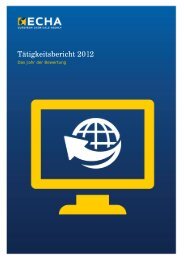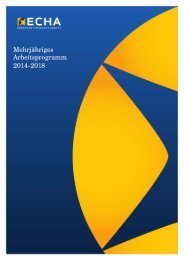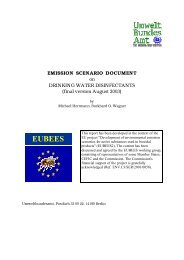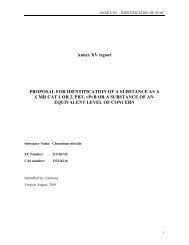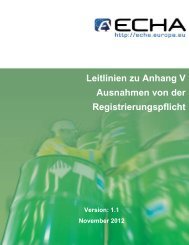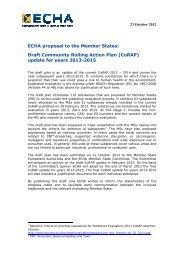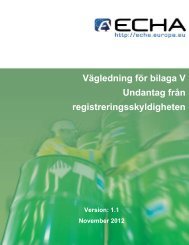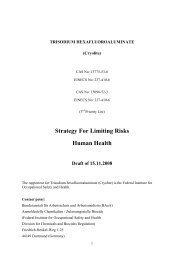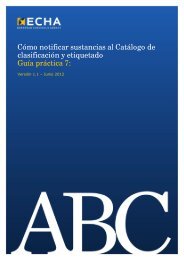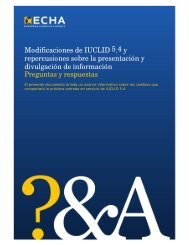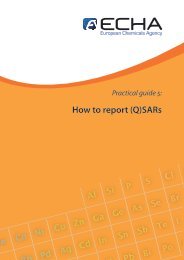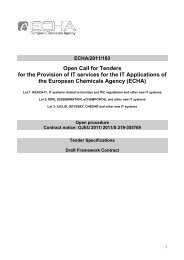Questions and answers on restrictions - ECHA - Europa
Questions and answers on restrictions - ECHA - Europa
Questions and answers on restrictions - ECHA - Europa
You also want an ePaper? Increase the reach of your titles
YUMPU automatically turns print PDFs into web optimized ePapers that Google loves.
11.2 Phthalates in articles used for the hygiene of children<br />
Are the articles destined to be used for the hygiene of children such as bathtubs, articles for<br />
the bath, bathtub mats, hairbrushes, bath thermometers, or nail cutters covered under Entries<br />
51 <str<strong>on</strong>g>and</str<strong>on</strong>g> 52?<br />
The entries 51 <str<strong>on</strong>g>and</str<strong>on</strong>g> 52 specify that “Childcare article” means “any product intended to facilitate<br />
sleep, relaxati<strong>on</strong>, hygiene, the feeding of children or sucking <strong>on</strong> the part of children.”<br />
As these articles are intended to facilitate the hygiene of children they should be c<strong>on</strong>sidered as<br />
“childcare articles” as defined by the entries 51 <str<strong>on</strong>g>and</str<strong>on</strong>g> 52.<br />
In c<strong>on</strong>clusi<strong>on</strong>, articles which are used for the hygienic care of children such as bathtubs,<br />
articles for the bath, bathtub mats, hairbrushes, bath thermometers, or nail cutters are<br />
therefore covered by the Entries 51 <str<strong>on</strong>g>and</str<strong>on</strong>g> 52 <str<strong>on</strong>g>and</str<strong>on</strong>g> use of phthalates <str<strong>on</strong>g>and</str<strong>on</strong>g> should c<strong>on</strong>form to the<br />
prescripti<strong>on</strong>s of the entries.<br />
11.3 Mattress protectors<br />
Do mattress protectors (covers, pads etc.) fall within the scope of entries 51 <str<strong>on</strong>g>and</str<strong>on</strong>g> 52<br />
of Annex XVII?<br />
The definiti<strong>on</strong> of childcare articles c<strong>on</strong>tained in Annex XVII to REACH is as follows:<br />
“Childcare articles” are defined as “any product intended to facilitate sleep, relaxati<strong>on</strong>,<br />
hygiene, the feeding of children or sucking <strong>on</strong> the part of children”.<br />
Further explanati<strong>on</strong> is provided by the Commissi<strong>on</strong> services’ guidance document <strong>on</strong> the<br />
interpretati<strong>on</strong> of the c<strong>on</strong>cept “which can be placed in the mouth”. It gives the following<br />
examples: “The main purpose of pyjamas is to dress children when sleeping <str<strong>on</strong>g>and</str<strong>on</strong>g> not to<br />
facilitate sleep. Pyjamas should therefore be regarded as textiles <str<strong>on</strong>g>and</str<strong>on</strong>g>, like other textiles, do<br />
not fall under the scope of the Directive. Sleeping bags are designed to facilitate sleep, <str<strong>on</strong>g>and</str<strong>on</strong>g><br />
should therefore fall under the Directive.”<br />
Taking this into account, <str<strong>on</strong>g>and</str<strong>on</strong>g> also taking into account that the guidance document explicitly<br />
c<strong>on</strong>tains a descripti<strong>on</strong> <str<strong>on</strong>g>and</str<strong>on</strong>g> a photo of a mattress cover, it can be c<strong>on</strong>firmed that mattress<br />
protectors are childcare articles as defined in Annex XVII.<br />
This means that the three phthalates DEHP, BBP <str<strong>on</strong>g>and</str<strong>on</strong>g> DBP listed in entry 51 of Annex XVII may<br />
not be used in mattress protectors. The other three, DINP, DIDP <str<strong>on</strong>g>and</str<strong>on</strong>g> DNOP, listed in the entry<br />
52, are <strong>on</strong>ly restricted in those articles that can be placed in the mouth by children.<br />
Can mattress protectors (covers, pads etc.) be placed in the mouth by children?<br />
The guidance document c<strong>on</strong>tains an example of a mattress cover that is not directly mouthable<br />
in normal <str<strong>on</strong>g>and</str<strong>on</strong>g> foreseeable use c<strong>on</strong>diti<strong>on</strong>s. The edges <str<strong>on</strong>g>and</str<strong>on</strong>g> corner are not accessible for<br />
mouthing by the child – by design (the mattress should fit snugly in the cot to avoid<br />
entrapment risks), <str<strong>on</strong>g>and</str<strong>on</strong>g> the mattress is covered with a sheet in normal use <str<strong>on</strong>g>and</str<strong>on</strong>g> the surface is<br />
sufficiently taut (by design – to avoid suffocati<strong>on</strong> risks) to prevent PVC from being mouthed<br />
through the sheet. This is based <strong>on</strong> the observati<strong>on</strong> that inaccessible parts of articles can not<br />
be taken into the mouth. Articles or parts of articles should be c<strong>on</strong>sidered inaccessible if,<br />
during proper use or reas<strong>on</strong>ably foreseeable improper use by children, they can not be<br />
reached.<br />
However, there will be other cases when parts of certain articles can be taken into the mouth<br />
under normal <str<strong>on</strong>g>and</str<strong>on</strong>g> foreseeable c<strong>on</strong>diti<strong>on</strong>s, for example when the mattress protector is placed<br />
<strong>on</strong> the sheet or cannot be completely fixed.



